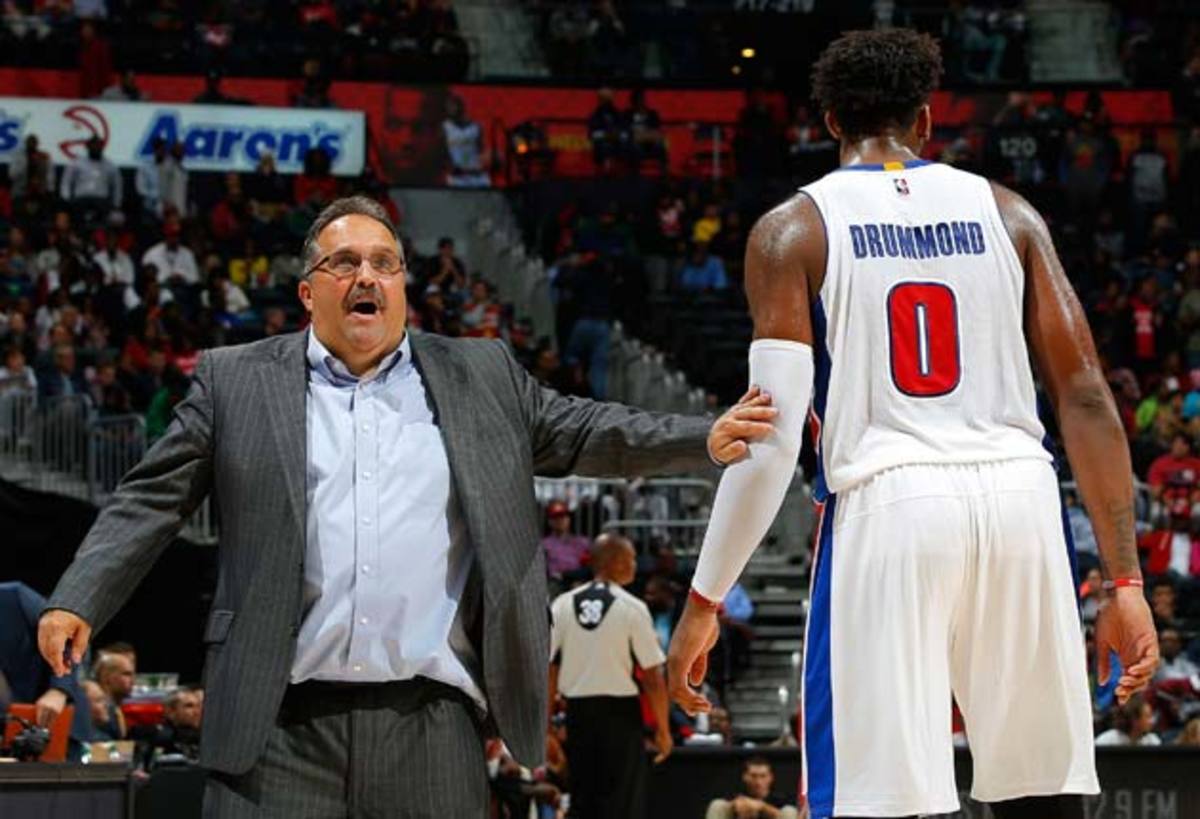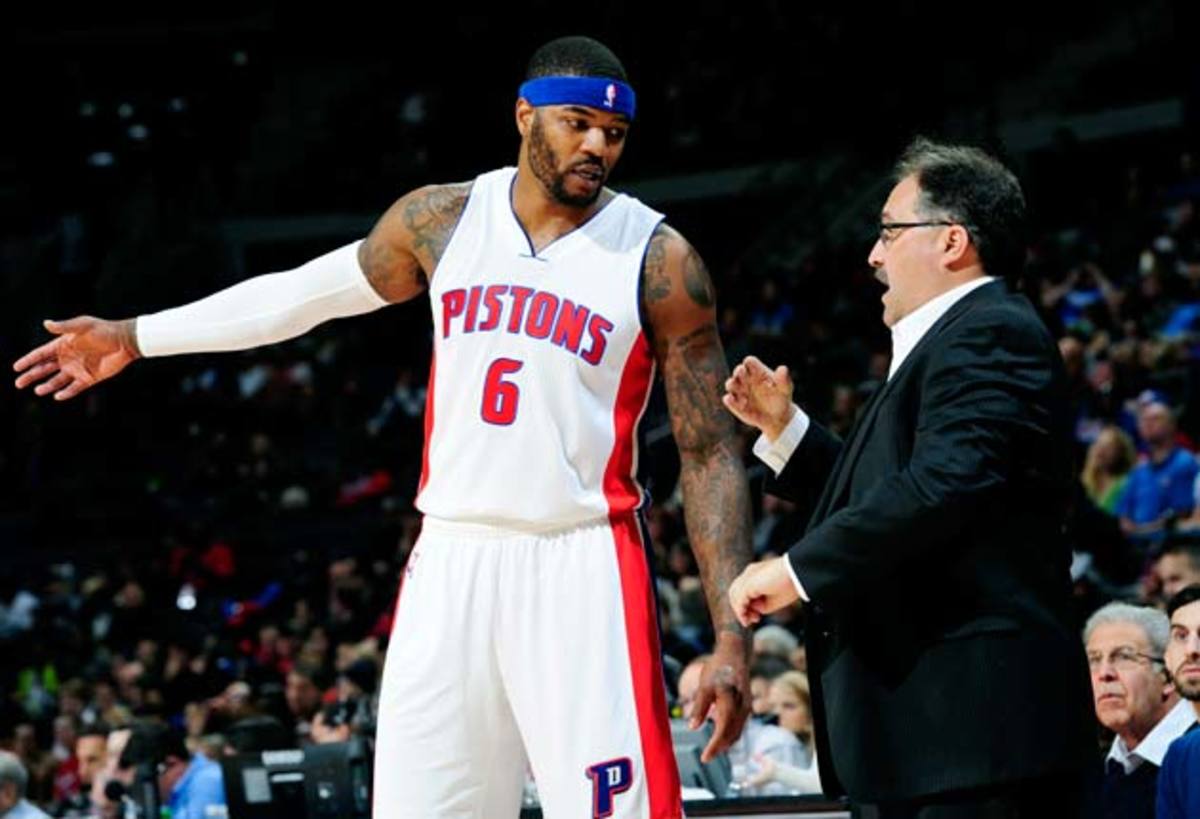Pistons leaving no game unwatched in hopes of uncovering the NBA's secrets

There will be 1,230 NBA games this season. The Detroit Pistons want to watch every one.
The Pistons have four pro scouts, and that’s their job: Watch basketball. A lot of basketball. Two or three games a day, all season. Last year, they watched between 90-95% of NBA games, and for each one, they evaluated every player in the game in several categories, and entered their scouting reports into the team’s database. The Pistons want to know everything relevant about every player in the league—and really, about every NBA-quality player in the world.
It’s an enormous and unprecedented effort that could change how business is done in the NBA.
You know… if it works.
In the spring of 2014, Stan Van Gundy pulled out of the Golden State Warriors’ coaching search to take full control of the Pistons. Outsiders tend to look at these jobs simply as vehicles for winning games, and by that standard, Van Gundy made a mistake. The Warriors have already won a championship. Nobody knows if they would have won it with Van Gundy coaching instead of Steve Kerr, but they would have had a great shot. Just about everybody in the NBA agrees Van Gundy is a terrific coach.
But after a Pistons practice recently, Van Gundy insisted, “If I had it to do over again, this is where I’d want to be.” He has a chance to do something that very few coaches ever get to do: Build an organization as he pleases. The Pistons’ owner, Tom Gores, has given him the budget and authority to do it.
70 reasons to watch the NBA this year
Van Gundy did not want control just for the sake of having it. He had a vision. Van Gundy has been a coaching grinder his whole professional life: watching film forever, preparing for every possible circumstance, worrying about every detail. When he hired his friend, Jeff Bower, to be the general manager in 2014, he told Bower he wanted to apply that kind of mindset to the front office.
They went on a hiring spree, the likes of which the NBA has never seen. In a year and change, the Pistons have gone from one of the league's smallest front-office staffs to one of the largest.
To understand the scope of what the Pistons are doing, go back a decade. It’s really not that much time, when you think about it. The Spurs were perennial contenders behind Tim Duncan, Gregg Popovich and Tony Parker. LeBron James was trying to end Cleveland’s championship drought. Again: Not a long time.
The 2004 Pistons basically had five people in their front office: a general manager (Joe Dumars), his three closest confidantes (John Hammond, Scott Perry, George David), and an international scout (Tony Ronzone).
That was it. Five people.
The current Pistons have those four pro scouts. The 2004 Pistons didn’t have any. If a player on another team became available at the trade deadline, or was about to hit free agency, Dumars and his staff already had an opinion on him. Sometimes they would watch some extra tape.
• 70 reasons to to watch this season | Previews: All 30 teams | Scouts takes
David and Perry would travel around the country seeing games, and sometimes Dumars and Hammond would drop in on one.
They did have an advance scout, watching teams that were coming up on the Pistons’ schedule. But an advance scout is really an extension of the coaching staff. Advance scouts help with game strategy, not player acquisition.
Crystal Ball: 2015-16 NBA predictions
Now? The Pistons have Van Gundy, Bower, three assistant general managers, a basketball-operations director, four pro scouts, six college/international scouts, two analytics software engineers and a director of strategic planning. That’s 18 people.
That’s just the front-office increase. Then there are the various support people who have been added. Everywhere you look, you see more people. The 2004 Pistons had one video coordinator. The 2015 Pistons have three.
The construction of the 2004 Pistons seems primitive and downright laughable now, until you remember: That team won the NBA championship.
Dumars’s Pistons were not outliers. The other teams that won championships in the aughts had similarly small front-office staffs. Today, Pat Riley’s front office in Miami is less than half the size of Detroit’s, and the Heat has been to five of the last 10 Finals. As Van Gundy builds his team, there is no doubt that his model is different. The Pistons have to show it is also better.

When you document more than 1,000 games, the idea is not to find some big championship secret. That’s not how this works. The goal is to find a lot of smaller clues—to see what other teams don’t see yet, and capitalize on it.
Now Bower can sit in his office and get an updated scouting report on each player in the league, each week of the season, in a variety of categories. One great or bad week can be an outlier, of course. But evaluating players every week means the Pistons should know if a player is rising or declining as it happens. A player may have an A-minus reputation and A-plus endorsement portfolio, but if he plays like a B player for a few weeks in a row, the Pistons want to know about it.
Everybody wants the next LeBron or Duncan. Those players tend to be easy to identify but hard to acquire—especially in a market like Detroit, which can’t lure top free agents as easily some other cities. The Pistons want to answer questions like this one that Bower poses: “Why does a guy go to another team and all of a sudden stand out, where he barely got an opportunity before?”
2015–16 NBA Finals predictions: Who will win the championship this year?
The sheer complexity of running a sports team is often lost on fans—especially in the NBA, where rosters are smaller than other sports, and one or two players can have an outsized influence on a team. NBA teams generally draft between one and three players each summer. It seems fairly simple.
But teams must evaluate hundreds of players around the globe every year. And teams don’t really know who will be available at the trade deadline, so they need to be prepared for every possibility.
• Mailbag: Tony Parker's future, OKC's chances, Lakers and more
The Pistons believe their approach paid off last winter, when they acquired point guard Reggie Jackson from Oklahoma City.
Jackson was Russell Westbrook’s backup, and that is how fans viewed him: As a backup. They weren’t alone. Bower says in the league, “there was a variety of opinion, I would imagine.” And Jackson’s public grumbling about his role did not help his reputation—he wanted to show he could be a starter before he hit free agency, but to some he looked like a complainer who didn’t care about winning.
The Pistons did not think Jackson would be available, but they scouted him thoroughly, because they scout everyone thoroughly. They loved what they saw of Jackson in his short stints as a starter, when Westbrook was hurt. They thought he would play even better in Van Gundy’s offense. And his age meant they could build around him.
When the Thunder indicated they were willing to deal Jackson, the Pistons pounced, acquiring him in a three-team deal with Utah. In two months with the Pistons, Jackson averaged 17.6 points and 9.2 assists, and the Pistons felt he had room to grow. The day after the season ended, he turned 25. The Pistons signed him to a five-year, $80-million contract this summer.
The Jackson contract seemed excessive to some. It’s easy to say the Pistons overpaid him for two good months. But the Pistons saw those two months up close, and they feel good about the investment.
“We liked his ability, but what we liked even more was a guy who we thought would not change once he got the money,” Van Gundy said. “This was a guy who was really driven to be as good as he could be. Even what we saw at the end of last year, which was really good, we thought he could go to a higher level, and would work really hard to get to a higher level. That was why we were able to make that bet.”
One for Flip: Wolves make Saunders proud after Silver helps team grieve
To win, the Pistons need to win a lot of bets like that—starting with the player-acquisition process. They are heavily into analytics, but their decisions are not purely driven by analytics. Bower points out that the pro scouts are basketball veterans. The idea is to blend old-school and new-school views. If the scouts and numbers don’t align, the Pistons want to know why.
They apply the same philosophies to college and international scouting that they use for pro scouting. Their scouting operation is massive, and unimaginable just a decade ago. The NBA is swimming in money, Gores is willing to spend it, and thanks to technology, scouts can watch most of the relevant games that take place anywhere in the world. As Bower says, “We are only limited by time.”
The tricky part is taking this volume of information and molding it into something useful. There is a risk in knowing so much: You can lose sight of what is important. The Pistons are well aware they are putting together a collection of people, not film clips. The people must be able to work together. Bower says, “Our target throughout the summer and all of last year was talent, character and compatibility.”
The Pistons got a first-hand lesson in incompatibility last season. Van Gundy’s first Pistons team had Andre Drummond, who will likely get a maximum contract from the Pistons next summer; Josh Smith, one of the NBA’s best forwards with Atlanta, and Greg Monroe, who signed a three-year, $50-million contract with Milwaukee this summer. That’s a lot of talent. Yet the Pistons started 5-23.

“I’ll be honest: I was really disappointed that I couldn’t make it work better at the beginning of last year,” Van Gundy said. “I look at that, and it still bothers me. I think that we had better players, certainly, than to be off to a 5-23 start. As a coach, you have a hard time with the fact that you couldn’t get it to work better.”
Last December, the Pistons waived Smith, who was an easy (and sometimes deserving) target of frustrations. But he was symptomatic of a larger problem: the pieces did not fit, offensively or defensively. Smith was a better player in Atlanta than in Detroit. Monroe is a highly skilled player and a good teammate, but playing next to Drummond highlighted weaknesses (slow feet, which give him trouble guarding smaller players, a limited outside shot) instead of his strengths (post moves, excellent hands).
This year’s Pistons may have comparable overall talent to the team that started 5-23, but they should be a much better team.
So far, the Pistons are pleased with their real-world application of Van Gundy’s vision. Drummond and guard Kentavious Caldwell-Pope are holdovers from Dumars’s regime, but most of the roster has turned over since last year. They think forward Ersan Ilyasova will fit their culture well. They love rookie forward Stanley Johnson of Arizona.
• Open Floor podcast: Kyle Lowry discusses Raptors, DeMarre Carroll, more
Johnson is an example of relationships and classic scouting. Van Gundy worked with Arizona coach Sean Miller at Wisconsin in the 1990s. He trusted Miller’s evaluation of Johnson’s character and toughness. Van Gundy believes character rarely changes once a player enters the league—some guys may mature significantly, but most don’t. Johnson is the rare top-10 pick who instantly improves a team’s culture.
“There is just something about him,” Van Gundy said. “He is a great, great competitor. Every guy in that draft, you have to get better if you’re going to make an impact in this league. What you’ve gotta bank on is their work ethic and commitment to being great.”
As Van Gundy went through the roster, from the young building blocks to the veterans coming off the bench, he said, “I love our guys.” The Pistons won their opener in Atlanta on Tuesday and may be one of the surprise teams in the league. But internally, they won’t be surprised. They have done their homework.
